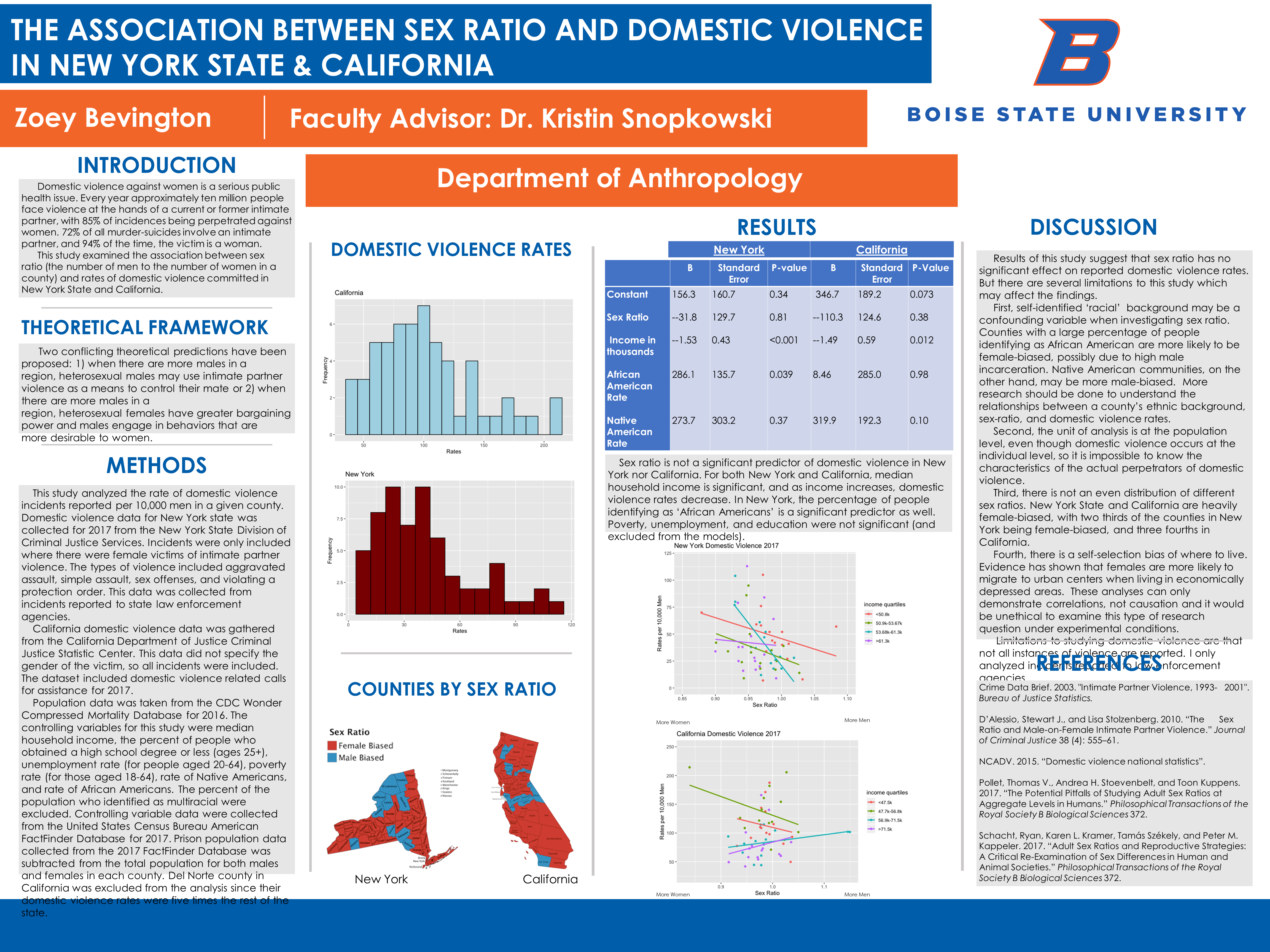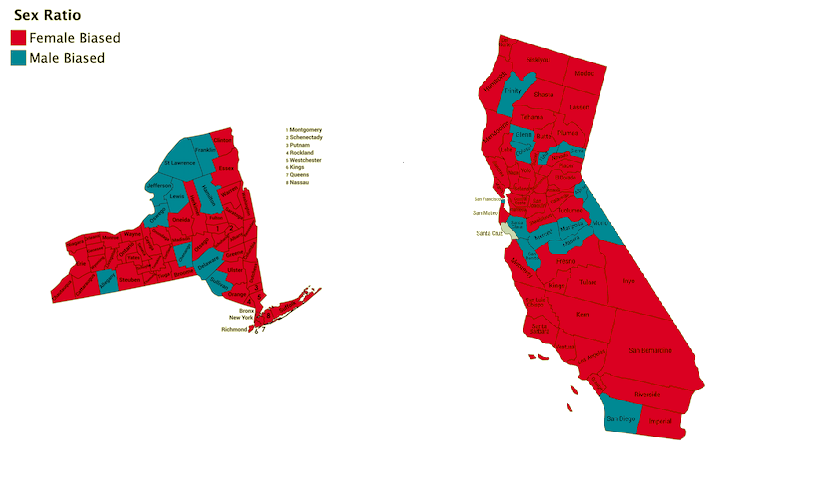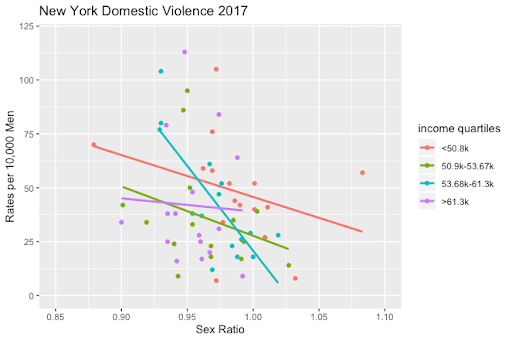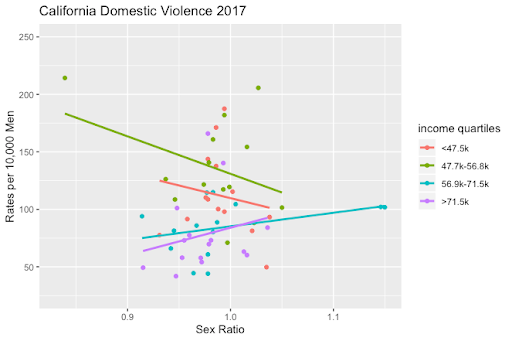Zoey Bevington, Dr. Kristin Snopkowski

Introduction
Domestic violence against women is a serious public health issue. Every year approximately ten million people face violence at the hands of a current or former intimate partner, with 85% of incidences being perpetrated against women. 72% of all murder-suicides involve an intimate partner, and 94% of the time, the victim is a woman.
This study examined the association between sex ratio (the number of men to the number of women in a county) and rates of domestic violence committed in New York State and California.
Theoretical Framework
Two conflicting theoretical predictions have been proposed:
- when there are more males in a region, heterosexual males may use intimate partner violence as a means to control their mate or
- when there are more males in a region, heterosexual females have greater bargaining power and males engage in behaviors that are more desirable to women.
Methods
This study analyzed the rate of domestic violence incidents reported per 10,000 men in a given county. Domestic violence data for New York state was collected for 2017 from the New York State Division of Criminal Justice Services. Incidents were only included where there were female victims of intimate partner violence. The types of violence included aggravated assault, simple assault, sex offenses, and violating a protection order. This data was collected from incidents reported to state law enforcement agencies.
California domestic violence data was gathered from the California Department of Justice Criminal Justice Statistic Center. This data did not specify the gender of the victim, so all incidents were included. The dataset included domestic violence related calls for assistance for 2017.
Population data was taken from the CDC Wonder Compressed Mortality Database for 2016. The controlling variables for this study were median household income, the percent of people who obtained a high school degree or less (ages 25+), unemployment rate (for people aged 20-64), poverty rate (for those aged 18-64), rate of Native Americans, and rate of African Americans. The percent of the population who identified as multiracial were excluded. Controlling variable data were collected from the United States Census Bureau American FactFinder Database for 2017. Prison population data collected from the 2017 FactFinder Database was subtracted from the total population for both males and females in each county. Del Norte county in California was excluded from the analysis since their domestic violence rates were five times the rest of the state.
Domestic Violence Rates


Counties by Sex Ratio

Results
| Category | B, New York | Standard Error, New York | P-Value, New York | B, California | Standard Error, California | P-Value, California |
|---|---|---|---|---|---|---|
| Constant | 156.3 | 160.7 | 0.34 | 346.7 | 189.2 | 0.073 |
| Sex Ratio | --31.8 | 129.7 | 0.81 | --110.3 | 124.6 | 0.38 |
| Income in Thousands | --1.53 | 0.43 | <0.001 | --1.49 | 0.59 | 0.012 |
| African-American Rate | 286.1 | 135.7 | 0.0039 | 8.46 | 285.0 | 0.98 |
| Native American Rate | 273.7 | 303.2 | 0.37 | 319.9 | 192.3 | 0.10 |
Sex ratio is not a significant predictor of domestic violence in New York nor California. For both New York and California, median household income is significant, and as income increases, domestic violence rates decrease. In New York, the percentage of people identifying as ‘African Americans’ is a significant predictor as well. Poverty, unemployment, and education were not significant (and excluded from the models).


Discussion
Results of this study suggest that sex ratio has no significant effect on reported domestic violence rates. But there are several limitations to this study which may affect the findings.
First, self-identified ‘racial’ background may be a confounding variable when investigating sex ratio. Counties with a large percentage of people identifying as African American are more likely to be female-biased, possibly due to high male incarceration. Native American communities, on the other hand, may be more male-biased. More research should be done to understand the relationships between a county’s ethnic background, sex-ratio, and domestic violence rates.
Second, the unit of analysis is at the population level, even though domestic violence occurs at the individual level, so it is impossible to know the characteristics of the actual perpetrators of domestic violence.
Third, there is not an even distribution of different sex ratios. New York State and California are heavily female-biased, with two thirds of the counties in New York being female-biased, and three fourths in California.
Fourth, there is a self-selection bias of where to live. Evidence has shown that females are more likely to migrate to urban centers when living in economically depressed areas. These analyses can only demonstrate correlations, not causation and it would be unethical to examine this type of research question under experimental conditions.
Limitations to studying domestic violence are that not all instances of violence are reported. I only analyzed incidents reported to law enforcement agencies.
References
- Crime Data Brief. 2003. “Intimate Partner Violence, 1993- 2001”. Bureau of Justice Statistics.
- D’Alessio, Stewart J., and Lisa Stolzenberg. 2010. “The Sex Ratio and Male-on-Female Intimate Partner Violence.” Journal of Criminal Justice 38 (4): 555–61.
- NCADV. 2015. “Domestic violence national statistics”.
- Pollet, Thomas V., Andrea H. Stoevenbelt, and Toon Kuppens. 2017. “The Potential Pitfalls of Studying Adult Sex Ratios at Aggregate Levels in Humans.” Philosophical Transactions of the Royal Society B Biological Sciences 372.
- Schacht, Ryan, Karen L. Kramer, Tamás Székely, and Peter M. Kappeler. 2017. “Adult Sex Ratios and Reproductive Strategies: A Critical Re-Examination of Sex Differences in Human and Animal Societies.” Philosophical Transactions of the Royal Society B Biological Sciences 372.
Additional Information
For questions or comments about this research, contact Zoey Bevington at zoeybevington@u.boisestate.edu